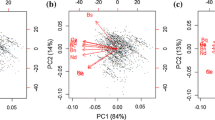Summary
Quantitative genetic theory for autogamous crops enables the estimation of the parameters m (F∞-mean) and D (F∞-variance) in the F3-generation. With these estimated m and D a prediction can be made of the probability of finding superior inbred lines in the F∞-offspring of the cross. The accuracy of this procedure is influenced by the correctness of the genetic model, by the magnitude of the error variance, and by the bias caused by intergenotypic competition, which is present in the environment in which the F3 is grown and absent in the monoculture environment at which the selection is aimed, especially in a cereal crop like wheat. The influence of the latter was investigated by a special method of simulating segregating populations. In this method genotypes in the offspring of a cross are represented by varieties and segregating populations are composed by mixing the appropriate varieties according to the proper segregation frequencies. Growing the simulated population enables the estimation of m and D in the normal selection environment, while simultaneously growing the varieties in a large monoculture trial enables the calculation of ‘true’ values of m and D in the monoculture environment. Hence, a comparison is possible.
The second of this set of two papers presents the investigations on the influence of intergenotypic competition on the estimation of the parameter D. The correlation between the estimates from the selection environment and the calculated ‘true’ values from the monoculture environment was low. On the average the true values were overestimated, however in a few cases the monoculture values were significantly underestimated. Using the estimated m's and D's to rank crosses may lead to rather erroneous results.
Similar content being viewed by others
References
Bulmer, M.G., 1985. The mathematical theory of quantitative genetics. Clarendon Press, Oxford, 255 pp.
Caligari, P.D.S. & W. Powell, 1986. The effects of competitive interactions on variances and on seed germination in spring barley (Hordeum vulgare). Heredity 57: 331–334.
Caligari, P.D.S., W. Powell & J.L. Jinks, 1985. The use of doubled haploids in barley breeding. 2. An assessment of univariate cross prediction methods. Heredity 54: 353–358.
Hogg, R.V. & A.T. Craig, 1978. Introduction to mathematical statistics, 4th edn Macmillan Publishing Co., Inc., New York, 438 pp.
Kearsey, M.J., 1985. The effect of linkage on additive genetic variance with inbreeding an F2. Heredity 55: 139–143.
Kramer, Th., J.W.van Ooijen & C.J.T. Spitters, 1982. Selection for yield in small plots of spring wheat. Euphytica 31: 549–564.
Mather, K. & J.L. Jinks, 1971. Biometrical genetics, 2nd edn. Chapman and Hall, London, 382 pp.
Mather, K. & J.L. Jinks, 1971. Introduction to biometrical genetics. Chapman and Hall, London, 231 pp.
Ooijen, J.W.van, 1989. The predictive value of quantitative genetic parameters in autogamous crops: Bias caused by intergenotypic competition. 1. F∞-mean. Euphytica 44: 81–94.
Spitters, C.J.T., 1979. Competition and its consequences for selection in barley breeding. Pudoc, Wageningen. Agric. Res. Rep. (Versl. landbouwk. Onderz.) 893, 268 pp.
Spitters, C.J.T., 1984. Effects of intergenotypic competition on selection. In: W. Lange, A.C. Zeven & N.G. Hogenboom (Eds), Efficiency in plant breeding: Proceedings 10th Congress of EUCARPIA. Pudoc, Wageningen, pp. 13–27.
Author information
Authors and Affiliations
Rights and permissions
About this article
Cite this article
van Ooijen, J. The predictive value of quantitative genetic parameters in autogamous crops: Bias caused by intergenotypic competition. 2. F∞-variance. Euphytica 44, 95–108 (1989). https://doi.org/10.1007/BF00022604
Received:
Accepted:
Issue Date:
DOI: https://doi.org/10.1007/BF00022604




